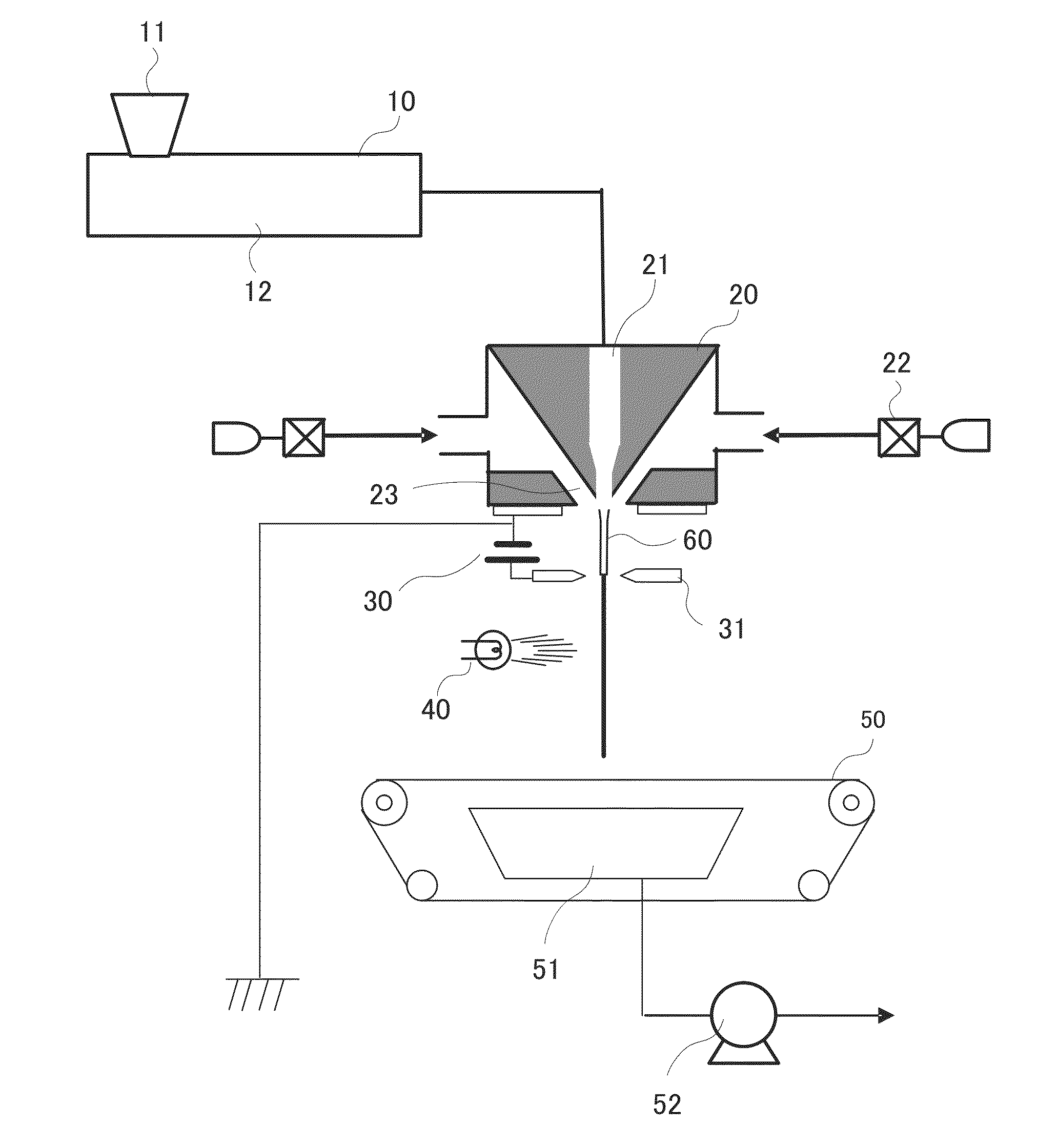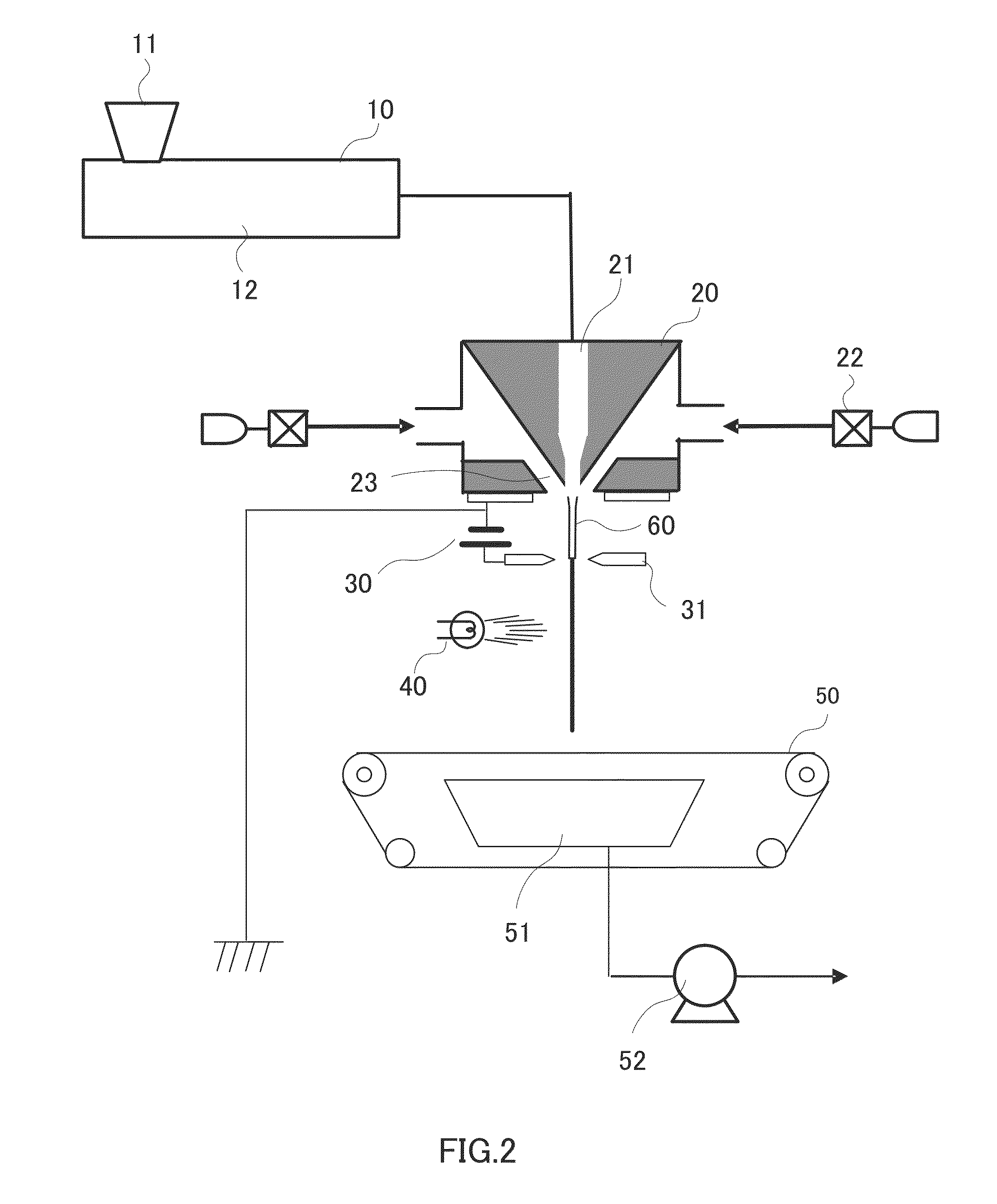Non-woven fiber fabric, and production method and production device therefor
a technology of non-woven fibers and production methods, applied in the field of non-woven fibers, can solve the problems of complex process, solvents that cannot be completely removed, and solvents containing a certain amount, and achieve the effect of simple production flow
- Summary
- Abstract
- Description
- Claims
- Application Information
AI Technical Summary
Benefits of technology
Problems solved by technology
Method used
Image
Examples
examples
[0123]The present invention will now be more specifically described based on Examples, which however shall not be construed as limiting the scope of the present invention.
[0124]The physical property values and the like in Examples and Comparative Examples were measured by the following methods.
(1) Average Fiber Diameter (μm) of Fibers of Nonwoven Fiber Fabric
[0125]A photograph of a nonwoven fiber fabric at a magnification of 1,000× was taken using an electron microscope (S-3500N manufactured by Hitachi, Ltd.). Any 100 fibers were chosen among from fibers constituting the nonwoven fiber fabric, and the width (diameter) of the chosen fibers was measured. The average of the measurements was taken as the average fiber diameter.
(2) Maximum Pore Diameter (μm), Minimum Pore Diameter (μm), and Average Pore Diameter (μm) of Nonwoven Fiber Fabric
[0126]In a constant temperature room having a temperature of 20±2° C. and a humidity of 65±2% defined in JIS Z8703 (Standard Atmospheric Conditions f...
example 2
[0137]Spinning was performed by the same method as in Example 1 except that the distance of the application ring from the gas nozzle surface (d2 in FIG. 4) was 20 mm, to obtain a nonwoven fabric laminate in which a nonwoven fiber fabric having a basis weight of 2 g / m2 and an average fiber diameter of 0.5 μm was laminated on a spunbonded nonwoven fabric. The diameter of the molten resin at a position at a distance from the gas nozzle surface (d2 in FIG. 4) of 20 mm (the position where the application ring was disposed) was 0.8 μm. The physical properties of the obtained nonwoven fabric laminate were measured by the methods described above. The results are shown in Table 1.
example 3
[0138]Spinning was performed by the same method as in Example 1 except that lamination on a spunbonded nonwoven fabric was not performed, to produce a nonwoven fiber fabric (single layer) having a basis weight of 10 g / m2 and an average fiber diameter of 0.3 μm. The physical properties of the obtained nonwoven fiber fabric were measured by the methods described above. The results are shown in Table 1.
PUM
| Property | Measurement | Unit |
|---|---|---|
| diameter | aaaaa | aaaaa |
| pore diameter | aaaaa | aaaaa |
| diameter | aaaaa | aaaaa |
Abstract
Description
Claims
Application Information
 Login to View More
Login to View More - R&D
- Intellectual Property
- Life Sciences
- Materials
- Tech Scout
- Unparalleled Data Quality
- Higher Quality Content
- 60% Fewer Hallucinations
Browse by: Latest US Patents, China's latest patents, Technical Efficacy Thesaurus, Application Domain, Technology Topic, Popular Technical Reports.
© 2025 PatSnap. All rights reserved.Legal|Privacy policy|Modern Slavery Act Transparency Statement|Sitemap|About US| Contact US: help@patsnap.com



